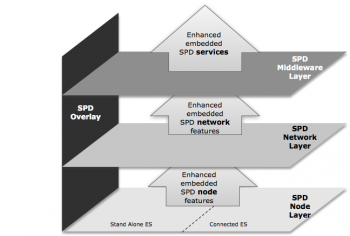PSHIELD-public
| Wiki for ITS | ||||||
|---|---|---|---|---|---|---|
|
Contents
Public Web page of pSHIELD
The pSHIELD project aims at being a pioneer investigation to address Security, Privacy and Dependability (SPD) in the context of Embedded Systems (ESs) as “built in” rather than as “add-on” functionalities, proposing and perceiving with this strategy the first step toward SPD certification for future ES. The leading concept is to demonstrate composability of SPD technologies. Starting from current SPD solutions in ESs, the project will develop new technologies and consolidate the available ones in a solid basement that will become the reference milestone for a new generation of “SPD-ready” ESs. pSHIELD will approach SPD at 4 different levels: node, network, middleware and overlay. For each level, the state of the art in SPD of single technologies and solutions will be improved and integrated (hardware and communication technologies, cryptography, middleware, smart SPD applications, etc.). The SPD technologies will be enhanced with composable functionality, in order to fit in the pSHIELD architectural framework.
Source(s): pSHIELD project
The composability of SHIELD architectural framework will have great impact on the system design costs and time to market of new SPD solutions in ESs. At the same time, the integrated use of SPD metrics in the SHIELD framework will have impact on the development cycles of SPD in ESs because the qualification, (re-)certification and (re-)validation process of a SHIELD framework instance will be faster, easier and widely accepted.
The use of an overlay approach to SPD and the introduction of semantic technologies address the complexity associated with the design, development and deployment of built-in SPD in ESs. Using semantics, the available technologies can be automatically composed to match the needed, application specific SPD levels, resulting also in an effort reduction during all the design, operational and maintaining phases. The pSHIELD approach is based on modularity and expandability, and can be adopted to bring built-in SPD solutions in all the strategic sector of ARTEMIS, such as transportation, communication, health, energy and manufacturing.
In order to verify these important achievements, the project will validate the SHIELD integrated system by means of an application scenario: monitoring of freight trains transporting hazardous material.
The Artemis prosjektet pSHIELD (pilot embedded Systems arHItecturE for multi-Layer Dependable solutions) har fått støtte av Norges forksningsråd under prosjektnr 203172/I40 den 2 juli 2010.
The Norwegian contribution described here is part of the multi-national Artemis pSHIELD project ES459356. [The Kick-off took place on 8. June 2010]
The project partners are: SESM scarl (Coordinator), Elsag Datamat, Selex Comms, ANSALDO-STS, Eurotech, STM, TRS, Università Genova, Università Sapienza Roma,ATHENA, Hellenic Aerospace, Integrated Systems Development, European Software Institute, Mondragon Goi Eskola Politeknikoa , Critical SW, Atos-Origin, Center for Wireless Innovation Norway, Movation AS, THYIA Tehnologije, Acorde Seguridad
Source(s): pSHIELD project
Work packages
The following work packages are identified for pSHIELD
- Task 1.1 - Project management
- Task 1.2 - Liaisons
WP2 - SPD Metric, requirements and system design
- Task 2.1 - Multi-technology requirements & specification
- Task 2.2 - Multi-technology SPD metrics
- Task 2.3 - Multi-technology architectural design
- Task 3.1 - Nano, micro/personal node
- Task 3.2 - Power node
- Task 3.3 - Dependable self-x and cryptographic technologies
- Task 4.1 - Smart SPD driven transmission
- Task 4.2 - Trusted and dependable Connectivity
WP5 - SPD Middleware & Overlay
- Task 5.1 - SPD driven Semantics
- Task 5.2 - Core SPD services
- Task 5.3 - Policy-based management
- Task 5.4 - Overlay monitoring and reacting system by security agents
WP6 - Platform integration, validation & demonstration
- Task 6.1 - Multi-Technology System Integration
- Task 6.2 - Multi-Technology Validation & Verification
- Task 6.3 - Lifecycle SPD Support
- Task 6.4 - Multi-Tecnology Demonstration
WP7 - Knowledge exchange and industrial validation
- Task 7.1 - Dissemination
- Task 7.2 - Exploitation
Source(s): pSHIELD project
Expected Impact to Norwegian Industry
pShield is a pilot demonstrator to enable embedded systems as real-time providers for industrial processes. The specific use case targeted for this project is the sensor integration from trains into an embedded system (ES) management tool. The use case providers are the Norwegian Rail Administration (Jernbaneverket - JBV) and Telenor Objects, with Movation acting as a mediator between the academic and the use-case partners.
The exploitation of the results is essential for demonstrating the economic impact of the research. All involved norwegian partners/industries are committed to the exploitation of the results. Exploitations of the pSHIELD-N results will offer a strategic opportunity for the longer-term development of our Norwegian partners’ business both in Europe and globally. Success of commercial exploitation of one use cases may open the possibility of extending it to similar use cases having substantial business opportunities in bigger market segments for Norwegian industries. For the telecommunication operators, competition is quite high in their core market segments and unconventional services to other areas will increase the revenue of these companies.
Source(s): pSHIELD project
Contact
For further information, please contact
- Norwegian partner representation: Josef Noll, Movation AS, mail:josef.noll@movation.no
- CWI representativ Mushfiq Chowdhury, CWI, email:mohammad@unik.no
Source(s): pSHIELD project
